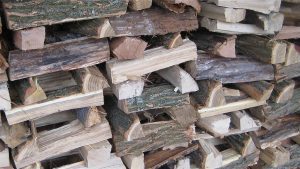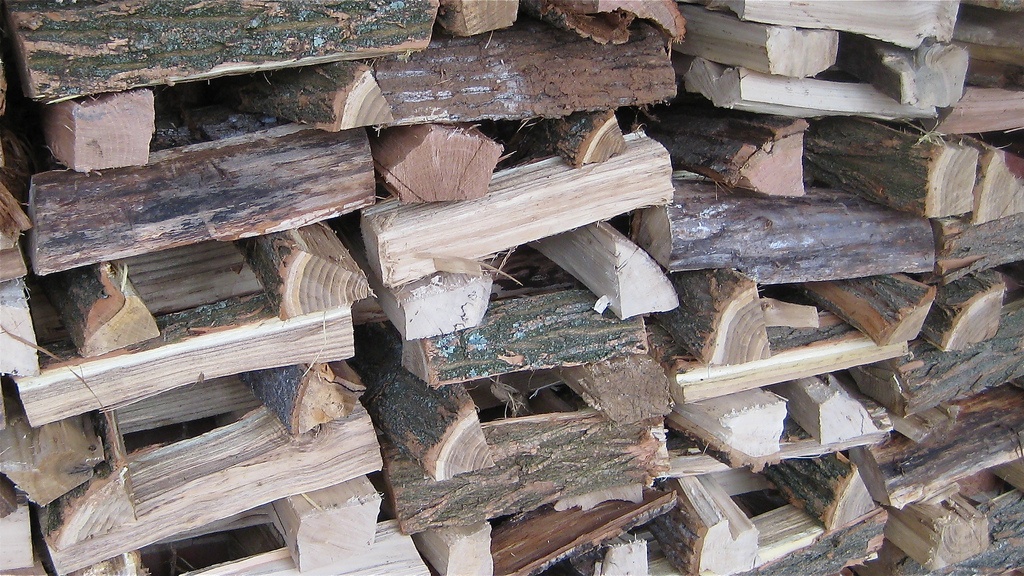Whether you buy firewood or harvest it yourself, it’s important to know which kind is best for your fireplace or wood stove, as well as how best to dry, season, and store it. There are many firewood alternatives worth exploring too. We’ll cover the entire spectrum here, along with pros and cons plus some tricks to split firewood easier, heating values, and more.
Types of Firewood
You may already know that there are two different types of firewood: hardwood and softwood. Availability depends on your location.
Hard Woods vs Soft Woods: Pros and Cons
- Hard woods are densest. They typically burn longer and hotter than soft woods.
- Hardwood species aren’t as sappy or sticky as softwoods; they produce less tar, meaning less buildup in your chimney and easier/faster chimney cleaning.
- Hard woods typically produce less smoke than soft woods.
- Soft woods are often cheaper than hard woods, depending on location.
- Soft woods season faster than hard woods, in most cases.
- Soft woods tend to ignite faster and easier.
Popular Hardwood Species:
Popular Softwood Species:
- Cedar
- Larch
- Pine
Traditional Firewood Alternatives
If you’re harvesting your own firewood and it needs to be seasoned, or if you are all out of firewood but have some cold days ahead, there are some alternatives to traditional firewood. Here are a few to consider.
- Manufactured “log” products made with compressed sawdust, woodchips, etc. These are often quite efficient.
- Pellets are designed to be used in pellet stoves, but you can burn them in a standard wood stove if you need to. These don’t last as long as compressed fire logs.
- Wood chips don’t last long in the fireplace, but they can be burnt and they make excellent kindling.
- Dimensional lumber such as 2x4s – This can be useful as kindling, but it’s not a good primary fuel source as it burns ultra-fast and hot, and can cause overfiring and a subsequent chimney or house fire.
You might be tempted to burn old plywood in your woodstove or fireplace. Don’t do it! The chemicals it contains can be dangerous to inhale when burnt, and they can damage your fireplace or woodstove.

Harvesting Firewood
Harvesting firewood is a great way to save money, enjoy time outdoors, and get some excellent exercise. Be sure to cut firewood only where legal, and to check into local and national regulations and permits for cutting firewood.
If you have access to wood on your own land, you’re in luck! Harvesting firewood won’t require a permit in most cases, nor will it call for much of an investment in fuel for your truck. As for how much time it will take, this depends on how many people you have to help, and how much firewood you need. Many people take on this task in small chunks rather than investing entire days or weeks to the wood gathering process.
What to Watch Out For
While you can certainly harvest firewood in spring and summer, be careful of the local flora and fauna! You’ll want to be on the lookout for snakes, and you will need to keep a careful eye out for poison ivy vines on firewood species.
If either is a concern, come back during cold weather. Carefully remove the poison ivy vines as they can still cause a reaction even when dry/dead. Be sure to get them all off the wood before you bring it home; burning poison ivy releases toxins into the air and these can cause severe eye, skin, and lung reactions.
How to Cut Firewood
Look for dead trees instead of going after green ones. Dead (but not rotting) trees are already partly aged, and this means a far shorter drying/seasoning time once you get the wood cut, split, and stacked. Be sure that there are no animals living inside before you go to harvest old, dead trees.
If you are not familiar with the process of felling a tree, it’s a good idea to get lessons in person from someone who knows how. Once the tree is down, use your chainsaw to remove the limbs, and then cut the limbs and the logs into 16-inch sections for transport.
How to Split Firewood
There are a few tricks to split firewood easier. The first is to choose the proper equipment. If you’re processing a minimal amount of wood, a heavy splitting maul and a smaller hatchet or axe will work. If you plan to split lots of wood, consider saving time and effort by obtaining a hydraulic splitter. Manual models are often available for less than $200, while gas or electric models represent a larger investment.
Here are a few more tricks for splitting firewood easier:
- Use a level chopping block (a tree stump is ideal).
- Consider fastening an old tire without a rim onto your chopping block, and set the logs upright inside the tire before chopping them. This can save quite a bit of bending.
- Don’t file splitting mauls and other large cutting tools to razor sharpness. These work best and resist chipping better when they are left with a blunt edge.
- Aim for the center when chopping smaller logs.
- Aim for the sides when splitting larger logs, breaking smaller side pieces away rather than attempting to split the wood straight down the middle.
- If a log contains large knots, place the knottier end down toward the chopping block and start your cuts in the clear wood on top.
- Splitting large, green logs might call for a wedge and a sledgehammer. Drive the edge of the wedge into the log and then strike it repeatedly with the sledgehammer until the log splits.
- Use the splitting maul to divide larger pieces of wood into smaller pieces.
- Use a smaller axe or hatchet to cut kindling. Be sure that your kindling tool is fairly sharp and wear gloves to avoid cutting yourself.
Splitting wood can feel like hard work even when you use these tips. It is a good idea to do a little each day and build your muscles!
How to Dry Firewood
Firewood takes an average of 6 to 9 months to dry depending on the location, temperature, air movement, and other variable factors. If you are harvesting your own firewood or having a company deliver green firewood at a reduced price, then you’ll want to take the following steps:
- Ensure that firewood has been cut to acceptable lengths. 16 inches is the average. Some people prefer shorter or longer pieces depending on the size of the wood stove or fireplace. If you’re not sure, you may want to check your owner’s manual or measure the area where the wood will be burned.
- To determine the correct firewood length for your wood stove or fireplace, measure the interior furnace length and subtract three inches from the length or width, depending on which direction firewood will be inserted into the furnace area.
- Split the wood. Do not wait until just before you burn wood to split it, as large logs take a long time to dry completely.
- If you want your wood to dry faster, split it into narrower pieces. These will burn faster, but you’ll have quicker access to the wood you are prepping now.
- If you have no woodshed, choose a sunny, breezy area for drying and seasoning firewood. Create a simple raised platform to keep your firewood from contacting bare ground. Concrete blocks are ideal – these do not absorb water, and you can lay pressure treated plywood across the top to create an even surface. If you like, you can lay the plywood directly on the ground or atop some pressure treated timbers. Whichever method you choose, ensure that water will not come into contact with the lower layer of your firewood.
- Lay a tarp or some protective plastic over the plywood. This will ensure that no moisture transfers from the wood into your firewood.
- Drill some drainage holes into the plastic and plywood at even intervals, ensuring that any rain water that does enter your stack will drain off quickly.
- Stack the firewood and leave it exposed to the sunlight. If you live in an area where rainfall is frequent or heavy, you should protect your firewood from moisture by building a loose tent with heavy black plastic or clear plastic sheeting (both materials do a good job of absorbing heat from the sun.) Use separate poles for this purpose, as you want the wood to breathe while preventing condensation from building up on the wood’s surface.
How to tell if firewood is dry
The best way to determine if firewood is dry is to obtain a wood moisture meter and test several pieces of wood from different parts of the wood pile. Wood is dry when it has a moisture content of less than 20 percent. After that, it’s probably not going to get much drier, even if you keep it stored for years.
How to tell if firewood is well-seasoned
Besides using a firewood moisture tester, you can check the wood’s color, aroma, and sound to determine if it’s ready for use:
- Well-seasoned wood has a darker color than fresh wood, and is sometimes yellowish or greyish instead of having a fresh “wood” color. The ends of the wood’s grains should have a slightly separated look.
- The aroma shouldn’t be “sappy” or “fresh.” Split a piece of the wood into kindling and inhale deeply from its center. If you detect a green, sweet aroma, it probably needs more drying time.
- Knock two kindling-sized pieces together. If the sound is dry and hollow, the wood is probably well-seasoned and ready to use.
If your wood still has bark, you can attempt to peel a piece off. Bark often flakes away from dry, well-seasoned firewood easily. If it must be peeled off, check for fresh, moist wood underneath. If you see signs of moisture, your wood probably needs more drying time.
Still not sure if your firewood is well-seasoned? There’s one more way to tell. In a protected area such as a firepit, build a test fire with kindling and firewood. If the wood is dry and ready to use, it will catch fire fairly easily, and it will not make hissing or steaming sounds. Any hissing is the sound of water boiling inside the wood, and it is an indicator that the firewood needs more drying time.
Storing Firewood
Because firewood can succumb to pest problems and rotting, it is vital that you store it carefully, preferably no less than 20 feet from your home. A dedicated woodshed is the ideal storage area, but you can easily create covered wood piles that keep any pests from nesting alongside your home, and that assure proper air circulation that’s essential to prevent rotting.
Store your firewood out of contact with the ground. Pallets are ideal, as are racks constructed with pressure treated lumber.
If you need to store firewood next to another building such as a barn or garden shed, ensure that you leave several inches of empty space between the wood pile and the side of the building. Closer placement can encourage moisture buildup and damage, and it can also serve as a hiding place for mice and other creatures.
You can store some firewood – enough for a few days – on a firewood rack on a covered porch or patio, but keep it out of contact with your home’s siding or decking. Use up most of this wood before refilling the rack so that pests don’t have the opportunity to build nests inside.
How to Stack Firewood
You’ll make the most of your storage space if you stack your firewood lengthwise rather than in a criss-cross pattern. The criss-cross pattern does a good job of allowing extra air flow though, so if you’re seasoning and storing wood in the same place and you have plenty of room, you might want to consider doing it this way.
Try to build a well-balanced stack, with different sized pieces throughout the entire stack. This way, you have easy access to a variety of wood sizes later when you want to build fires. Take a little time to do this. Rushing is a recipe for disaster!
Whatever you do, do not simply throw your firewood into a heap on the ground. The wood in the middle will be subject to moisture, and when you go to use it, you’re quite likely to find mold, fungus, and even pests. It does take a bit of effort to properly stack firewood, but the time investment results in warm, cozy fires you’ll enjoy all throughout the colder months.
Tips for Buying Firewood
Need to purchase firewood? These useful tips can help you no matter what your location. We recommend that you get to know as much as you can about your local firewood market before investing in wood for the winter.
- Buy from a reputable source: ask around and conduct a bit of research before making a decision.
- Obtain your wood early in the season.
- If possible, purchase an entire winter’s wood supply at once so you’re not stuck searching for firewood in mid-winter.
- Inspect the wood when it arrives, before the company starts to stack it. Look for clean wood, all cut in even lengths (16 inches is standard in most places). Refuse large pieces that have not been split, and do not accept stumps. The firewood should look and feel dry, and the pieces should be fairly uniform in size. It’s a good idea to test a piece or two with a firewood moisture meter, simply to ensure that you are truly getting the dry, seasoned firewood that you were promised.
- Make sure that you get the amount of wood that you pay for. Some vendors try to shortchange customers by criss-cross stacking firewood so that it looks like they’re getting a great value. Instead, there’s more air space in the wood pile – some sources estimate that the actual amount of wood in a 4×8 criss-crossed stack is about 50% of the amount contained in a straight stack the same size. If the wood is being stacked for you, insist on straight stacking and confirm that you’re getting the proper amount.
Firewood FAQs
As our wood-burning ancestors knew, just about any type of log, stick, or branch can be used for heating and even cooking. If you ever find yourself in a survival situation, just about anything will do. But when it comes to heating your home safely and efficiently, you may have the ability to get more in-depth information about the fuel you choose.
What is firewood biomass?
Firewood’s biomass is the stored energy within the wood’s physical structure. Any living thing – even your own body – has biomass! This might be determined by weight or by size. The easiest way to measure firewood biomass is by a measure called “cord.” Of course, density plays a factor. Heavier, denser wood has more biomass than lighter, less dense wood simply because the wood’s cellular structure is more tightly packed.
Firewood’s biomass is called “biofuel” as it burns. The energy it releases is felt as heat.
How much firewood is in a cord?
A traditional cord of firewood is three stacks, each measuring 8 feet long by 4 feet high by 16 inches across. In all, a cord measures 128 cubic feet. Be sure that firewood is tightly stacked when determining whether you have a full cord.
What is firewood heating value?
Firewood heating value depends on moisture content and the wood’s physical density. In general, drier, denser wood produces more heat than wetter, less dense wood. Firewood heating value is often measured in BTUs (British Thermal Units). While BTUs vary depending on the wood’s moisture content and other individual factors, some types of firewood outperform others. According to World Forest Industries firewood BTU chart, these are some of the best tree species for firewood, with BTUs measured by cord:
| Firewood Type | BTU Value |
|---|---|
| Eucalyptus | 34.5 million BTUs |
| Osage Orange | 32.9 million BTUs |
| Shagbark Hickory | 27.7 million BTUs |
| Eastern Hornbeam | 27.1 million BTUs |
| Black Birch | 26.8 million BTUs |
| Black Locust | 26.8 million BTUs |
| Blue Beech | 26.8 million BTUs |
| Ironwood | 26.8 million BTUs |
| Bitternut Hickory | 26.5 million BTUs |
| Douglas Fir | 26.5 million BTUs |
| Western Juniper | 26.4 million BTUs |
| Western Hemlock | 24.4 million BTUs |
| Beech | 24.0 million BTUs |
| Northern Red Oak | 24.0 million BTUs |
| Sugar Maple | 24.0 million BTUs |
| White Oak | 24.0 million BTUs |
These are just a few examples of popular firewood tree species. Availability varies by location, and if you compare a few different firewood BTU charts, you’ll probably notice that the BTU rating varies slightly from one to the next. It’s worth noting here that BTU rating isn’t all that matters when determining which firewood is best for your budget. If you have access to plenty of white oak at a good price and Osage orange costs a lot more, then you’ll get more heat for your money by choosing the white oak.
What is firewood moisture content and why does it matter?
Just like other plants, trees are designed to carry water throughout the entire organism’s structure. Even after a tree has been harvested or fallen of its own accord, it is likely to contain a large amount of accumulated water.
While it is true that wet wood will eventually burn, it’s not at all efficient, and the amount of smoke / steam that it produces is certain to be excessive. Even worse, burning wet wood can lead to rapid creosote buildup in your chimney, which causes reduced draft, and in worst case scenarios can lead to carbon monoxide buildup or a chimney fire.
It’s best to burn firewood that contains no more than twenty percent moisture. Old-timers had to make an educated guess about the moisture content of the wood they burned. We’re far more fortunate. Thanks to wood moisture meters, we can determine wood’s moisture content quickly and enjoy safe, efficient warmth in our homes. Moisture meter prices vary – a good one typically costs between $20 and $40 depending on where it’s purchased.
How much does it cost to buy firewood vs. harvesting it myself?
If you’re not interested in moonlighting as a lumberjack, you may want to look into purchasing firewood locally. In most areas, a cord of wood sells for an average of $50-$100. That’s quite a difference, and your local prices might be a quite a bit higher or perhaps a touch lower. In general though, firewood prices vary depending on location, wood type, delivery distance, and whether you obtain additional services such as splitting and stacking. We found that in some areas split, seasoned, stacked hardwood costs about $400 / cord.
Keep in mind that it’s not really “free” to harvest firewood. You may need to purchase a good chainsaw, as well as fuel and oil for that chainsaw. You’ll also need other firewood equipment such as an axe or even a mechanical splitter, depending on how much wood you’d like to process. Of course these investments pay off over time!
We recommend conducting a bit of research to determine the average local price of firewood before making a decision about where to buy it. Check online sources like Craigslist and Facebook marketplace, and call a few different sources to find out what’s available as well as what kind of help the individual or company can provide you with in terms of delivery and stacking. At the same time, keep in mind that the more work you do yourself, the more money you’re likely to save. You might save even more if you’re able to pick up your firewood from a central location rather than paying for delivery.
Do I need any special firewood equipment?
The answer to this question depends on what you plan to do! Most people need an axe and/or hatchet for splitting kindling and firewood. Those who harvest their own tend to require larger items including a chainsaw and perhaps a log splitter.




